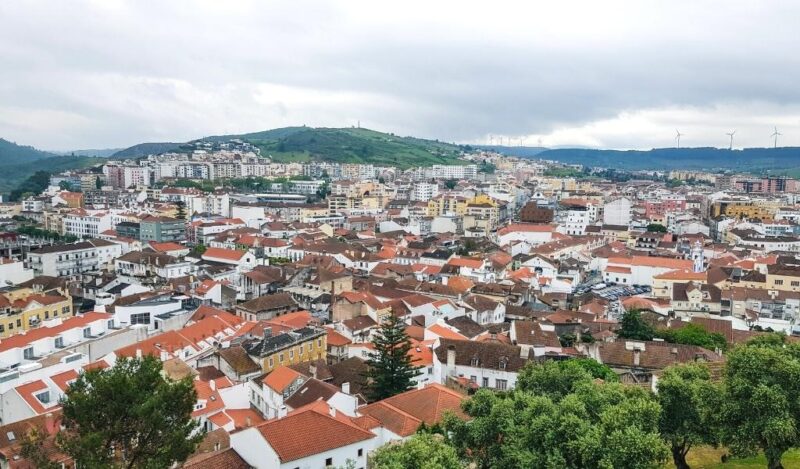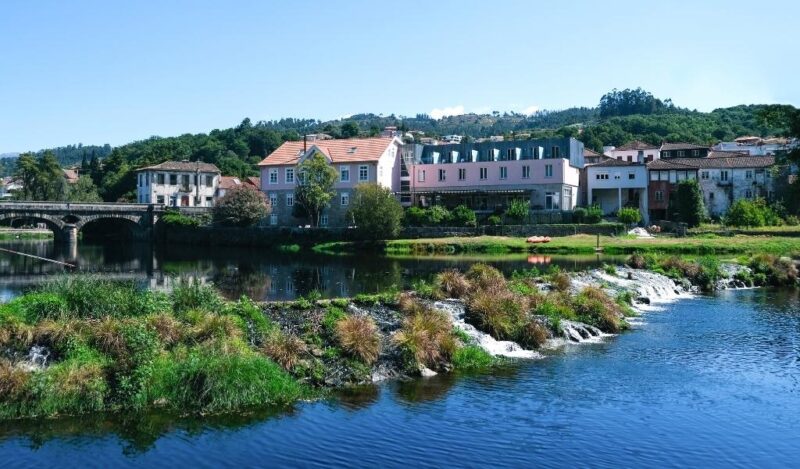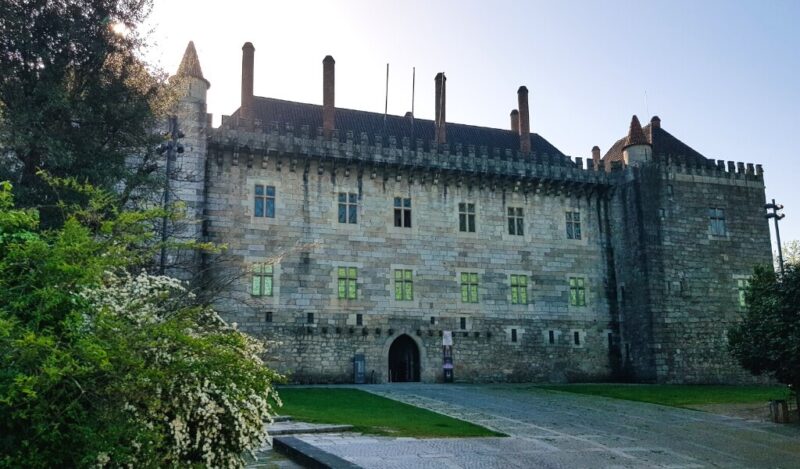The town of Sintra looks like something out of a fairy tale, with so many palaces, parks, gardens, and mansions. And it’s not news that Sintra is one of the best destinations for a day trip from Lisbon. However, after reading this Sintra itinerary, you’ll see why it’s so much better to spend two days in Sintra instead of one!
Inscribed as a UNESCO World Heritage Site in 1995, the Cultural Landscape of Sintra is located on the so-called “Portuguese Riviera” and houses some of the most iconic monuments and historic buildings in the country, such as the National Palace of Pena, the Moorish Castle, the National Palace of Sintra, the Quinta da Regaleira, the Palace of Monserrate, the Chalet of the Countess of Edla, the Convent of the Capuchos, and the Villa Sassetti!
So, do you want to know more about 2 Days In Sintra: The Perfect Sintra Itinerary? Keep reading!
This post may contain affiliate links, meaning I earn a small commission if you make a purchase, at no additional cost to you. Please read my disclosure & privacy policy for more information.
No time to read now? Pin it for later!


Brief History of Sintra
Like much of the Iberian Peninsula, the origins of the Portuguese town of Sintra date back to the Muslim occupation. Its integration into the Kingdom of Portugal dates from 1147, the year in which King Afonso Henriques (the first king of Portugal) conquered the region of Santarém and Lisbon, with the help of the Knights Templar.

Since then, the small town has become one of the favorites of Portuguese monarchs and nobles, due to its strategic location (especially its proximity to Lisbon and the Atlantic Ocean) and its microclimate (favorable for hunting and other recreational activities).
World Heritage
Did you know that the Cultural Landscape of Sintra was part of Portugal’s fourth set of inscriptions on the UNESCO World Heritage List? This 19th session of the World Heritage Committee took place in Berlin (Germany), between December 4th and 9th, 1995.
Nowadays, Portugal is the ninth country in Europe and the eighteenth country in the world with the most UNESCO sites, tied with Czechia and Poland. It has seventeen heritage assets (both cultural and natural) inscribed on the world list of the United Nations Educational, Scientific, and Cultural Organization.
In the meantime, I’ve already had the opportunity to visit fourteen of them:
- Alto Douro Wine Region (2001)
- Convent of Christ in Tomar (1983)
- Cultural Landscape of Sintra (1995) – Chalet of the Countess of Edla, Convent of the Capuchos, Moorish Castle, National Palace of Pena, National Palace of Sintra, Palace of Monserrate, Quinta da Regaleira, Villa Sassetti
- Garrison Border Town of Elvas and its Fortifications (2012)
- Historic Center of Évora (1986)
- Historic Center of Guimarães and Couros Zone (2001, 2023)
- Historic Center of Porto, Luiz I Bridge, and Monastery of Serra do Pilar (1996)
- Monastery of Alcobaça (1989)
- Monastery of Batalha (1983)
- Monastery of the Hieronymites and Tower of Belém in Lisbon (1983)
- Prehistoric Rock Art Sites in the Côa Valley (1998, 2010)
- Royal Building of Mafra – Palace, Basilica, Convent, Cerco Garden, and Hunting Park (Tapada) (2019)
- Sanctuary of Bom Jesus do Monte in Braga (2019)
- University of Coimbra – Alta and Sofia (2012)
Visiting Sintra
The three times I visited Sintra, I traveled by car – although I chose to leave it in a free car park (at the entrance to the town) and opt for the bus. This is something I highly recommend, especially during peak season. Not only is it difficult to find a space outside each palace, but the parking lot itself is quite expensive!


If you’re in Lisbon and want to travel by public transportation to Sintra, you can check the train timetables on the CP – Comboios de Portugal website. Once at the town’s train station, all you have to do is take bus 434 (to the Moorish Castle, the National Palace of Pena, and the Chalet of the Countess of Edla) or bus 435 (to the National Palace of Sintra, the Quinta da Regaleira, and the Palace of Monserrate).
Sintra Itinerary – Day 1
Palace of Monserrate
This Sintra itinerary begins at the Palace of Monserrate (in Portuguese, Palácio de Monserrate), a palace that doesn’t receive as many visits as the famous National Palace of Pena. Since it’s a few kilometers from the historic center, you should take the Scotturb bus 435 to get there or then travel by car/taxi.


The Monserrate estate is the perfect example of Romanticism in Portugal and what eclectic life would have been like in the 19th century. In addition, its “exotic” architecture results from a mixture of Gothic, Indian, and Moorish influences, blending perfectly with a botanical park where species from all over the world grow.
Read my complete guide to the Palace of Monserrate, a must-see tourist attraction on any Sintra itinerary!
Moorish Castle
After the Palace of Monserrate, it’s time to continue this Sintra itinerary at the Moorish Castle (in Portuguese, Castelo dos Mouros), one of the best-preserved castles in Portugal and, probably, the one with the best views. Officially called Sintra Castle, you can reach the Moorish Castle on foot, by car, or by Scotturb bus 434.


Constructed in the 10th century during the Muslim occupation of the Iberian Peninsula, the Moorish Castle enjoyed a very strategic location, on one of the highest peaks of the Sintra Mountains. Nevertheless, the fortress was conquered by King Afonso Henriques in 1147, thus becoming part of the Kingdom of Portugal!
Read my complete guide to the Moorish Castle, a must-see tourist attraction on any Sintra itinerary!
National Palace of Pena
There’s no Sintra itinerary that doesn’t include the National Palace of Pena (in Portuguese, Palácio Nacional da Pena) and this one is no exception. After all, this monument was elected one of the “7 Wonders of Portugal” in 2007! Reminiscent of Disney castles, the National Palace of Pena stands out for its bold colors and whimsical shapes.


The National Palace of Pena is also considered the first romantic palace in Europe. For that reason, it served as an inspiration to other historic buildings, including the stunning Neuschwanstein Castle in Germany, which was only built thirty years later!
Read my complete guide to the National Palace of Pena, a must-see tourist attraction on any Sintra itinerary!
Chalet of the Countess of Edla
The first day of this Sintra itinerary ends in the heart of Pena Park, more specifically at the Chalet of the Countess of Edla (in Portuguese, Chalet da Condessa d’Edla). Idealized by King Ferdinand II and Elise Hensler (his second wife), the Chalet of the Countess of Edla is situated less than two kilometers from the National Palace of Pena.

Unlike the former royal palace, the Chalet of the Countess of Edla is a much more modest residence. Designed in the style of alpine chalets, this small country retreat allowed the king and the countess to live away from the curious eyes and inconvenient comments of the Portuguese Court!
Read my complete guide to the Chalet of the Countess of Edla, a must-see tourist attraction on any Sintra itinerary!
Sintra Itinerary – Day 2
National Palace of Sintra
Let’s start the second and last day of this Sintra itinerary at the National Palace of Sintra (in Portuguese, Palácio Nacional de Sintra), in the heart of the town’s historic center. Did you know that this palace is the most important in Portugal, as it was the permanent (or temporary) residence of almost all the country’s kings and queens?


On top of that, it’s the oldest Portuguese palace of all, with over a thousand years of history and origins dating back to the Arab occupation of this region! In addition to dozens of magnificent halls, corridors, and rooms, the National Palace of Sintra is made up of numerous outdoor patios, covered galleries, and lush gardens.
Read my complete guide to the National Palace of Sintra, a must-see tourist attraction on any Sintra itinerary!
Villa Sassetti
The Villa Sassetti (in Portuguese, Vila Sassetti) is the perfect fusion of the Cultural Landscape of Sintra, with architectural and landscape details reminiscent of other monuments mentioned in this Sintra itinerary. And as this property is within walking distance of the Tourist Office, you don’t even need public transportation to get here!

The history of the Villa Sassetti began in 1885 when Victor Carlos Sassetti decided to build a summer house based on the castles of Lombardy. And to design it, he invited Luigi Manini (the architect responsible for the Quinta da Regaleira). The result was a Mediterranean-inspired “villa”, thanks to the circular tower in Lombard Romanesque style, the terracotta tones, the Portuguese tiles, and the granite from the Sintra Mountains!
Read my complete guide to the Villa Sassetti, a must-see tourist attraction on any Sintra itinerary!
Quinta da Regaleira
Like the National Palace of Sintra and the Villa Sassetti, you can reach the Quinta da Regaleira on foot. However, as you absolutely need a car to visit the Convent of the Capuchos, it might be a good idea to bring it here. Well, the Quinta da Regaleira is a must-visit monument for all lovers of architecture, landscaping, and even… mysticism!


Why mysticism, you ask? Because this property hides mystical structures and alchemical symbols linked to Freemasonry, the Templars, and the Rosicrucian Order! Built at the end of the 19th century, the Quinta da Regaleira comprises a luxurious palace and an enigmatic garden, which reflect the interests and ideologies of its first owner: the Brazilian-Portuguese millionaire António Augusto de Carvalho Monteiro!
Read my complete guide to the Quinta da Regaleira, a must-see tourist attraction on any Sintra itinerary!
Convent of the Capuchos
The Convent of the Capuchos (in Portuguese, Convento dos Capuchos) is the least visited point of interest in this Sintra itinerary, perhaps due to the fact that it’s not served by public transportation. But if you’re like me and you prefer to discover places with few people, then you really need to explore this former Franciscan convent!


Built with low environmental impact and in harmony with the green landscape that surrounds it, the Convent of the Capuchos is the ideal place for outdoor lovers. And it’s incredible to think that in this same historic town, you can visit sumptuous palaces and then buildings like this one, which seem to have been sculpted by Mother Nature!
Read my complete guide to the Convent of the Capuchos, a must-see tourist attraction on any Sintra itinerary!
Map of the Sintra Itinerary
Share this blog post on your social media!
More Posts about Portugal
4 Best Monasteries In Portugal (That You Should Visit This Year)
5 Best Palaces In Sintra (That You Should Visit This Year)
1 Day In Penafiel: The Perfect Penafiel Itinerary
More Posts about Travel Itineraries
1 Day In Penafiel: The Perfect Penafiel Itinerary
1 Day In Torres Vedras: The Perfect Torres Vedras Itinerary
2 Days In Arcos De Valdevez: The Perfect Arcos De Valdevez Itinerary
More Posts about World Heritage
Palace Of The Dukes Of Braganza: Best Tips For Visiting In 2024
World Heritage In Castile And León (2024)
Machado De Castro National Museum: Best Tips For Visiting In 2024
What Photography Gear Do I Use?
- Camera Body: Fujifilm X-T4 Mirrorless
- Camera Lens: Fujinon XF 18-55 mm F2.8-4 R LM OIS
- Tripod: Manfrotto Compact Action
- Small Tripod: Manfrotto PIXI Mini
- Smartphone Adaptor: Manfrotto PIXI Clamp
- Memory Card: SanDisk 128GB Extreme PRO SDXC








